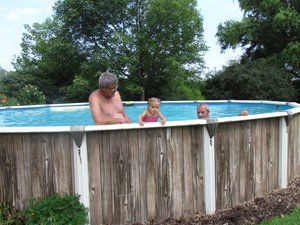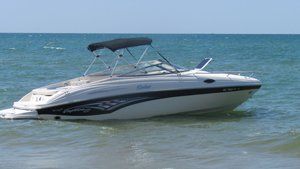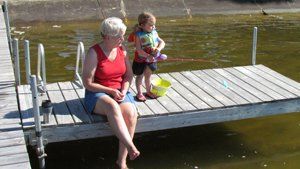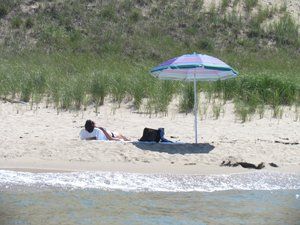Water Safety
#1 EFFECTIVE SUPERVISION
- Supervision is the first, and most critical line of defense to prevent drowning.
- Segment Supervision by designating a specific period of time to devote your complete and undivided attention to your child who is around water. Don’t answer the phone, read, etc. - give your child 100% of your attention.
- Designate one parent as the Water Watcher so there are never questions about which adult is responsible for watching the child.
Pool Safety
Permanent Fence
- Permanent 4-sided pool fence with a self-locking gate
- Periodically shake-test every part of your pool fence
- Do not allow your child to play on and/or climb the fence
- Remove patio furniture that may be pushed or pulled and used as a ladder
Locks/ Alarms
- Make sure all doors leading to the pool are locked and alarmed
- Alarms should indicate that someone is in the pool area or has opened/closed a door or gate, or trying to climb the fence
Pool Water
- Aim jets and in-floor jets to the shallow end of the pool
- Keep the water level at the uppermost point
- Waterfalls in pool areas create a noise level that may compete with a cry for help
Pool Toys
- Outdoor toys should be stored in an area that is isolated from the pool deck
- Keep your pool deck clean and clear
- Pool tools are not pool toys
Hot Tub Safety
SPAS, JACUZZIS AND HOT TUBS CAN BE PARTICULARLY ENTICING TO YOUNG CHILDREN
THINK OF IT FROM YOUR CHILD’S PERSPECTIVE… BUBBLES, JETS AND WARM WATER=FUN!
Water Temperature
- To prevent dehydration, or heat-related illness, keeping the water temperature below 100 degrees Fahrenheit is safer for small children
- Always check the temperature first with your hand before entering
Jets & Bubbles
- Keep the jets off, the currents that can be created by the jets can be particularly strong, and are very dangerous for a young child
- Bubbles in a hot tub drastically reduce visibility and make the water too interesting for little ones to want to investigate further
Covers & Locks
- When the spa or hot tub is not in use, secure it with a hard top cover with a latch that locks
Limit Play Time
- Limit your child’s playtime in the water to less than 10 minutes
- If your child’s face turns red, has nausea or dizziness, take the child out of the water immediately and apply cold water to the forehead with a saturated towel
Hot Tub Controls
- Find a way to prevent children from manipulating the controls for the hot tub. Once they find out how to activate the jets, they will, whether you are there or not.
In both Pools and Hot Tubs install VGB-Compliant Drain Covers.
One of the most important factors in keeping children and adults safe from entrapment incidents in pools and spas is to install anti-entrapment or safety drain covers.
For a full list of manufacturers of the VGB-compliant products visit
www.PoolSafely.gov
Boat & Lake Safety
Supervision
- Lakes and rivers can be especially dangerous because of their dark and sometimes fast-moving water, therefore effective supervision of your child anytime he is around the dock, river or lake is especially critical.
Safety Tools
- Have a rope or throw ring on your boat or dock such that these can be used in a moment’s notice
Towing
- When towing children and/or adults in pairs, use the rule when one falls, everyone falls. You never know when someone might be injured in the water
Bow Riding
- Do not allow small children to ride in front of the boat while the boat in moving, uncontrollable wake can propel a child from the boat
Everyone Onboard
- Account for everyone who should be on the boat BEFORE you start the engine
Cell Phone
- Always remember to bring a phone on the boat and place it in a designated spot. If you have to go into the water to rescue someone, will you remember to take it out of your pocket first?
LIFE JACKETS
If your family owns a boat, or you enjoy boating with others, there are several special precautions that need to be taken.
- Coast Guard regulations require that children always wear a life jacket on a boat
- Test your Life Jacket!!! Please be aware that many life jackets will float your child in a face down position… so test your life jacket before going out on the water
- Make sure life jacket fits your child appropriately and comfortably, and most importantly, make sure the life jacket you purchase will float your child face up even if unconscious
Dock Safety
Keeping it safe around a DOCK
If you have a dock on or near your property take special precautions:
- Paint or tape a brightly colored “do not cross” line on that dock at least 2-3 feet from the edge of the dock, and teach your child that they should never cross that line without a parent
- Dock pylons are often covered in algae or barnacles and it can be impossible to hold on if they fall in the water. Instead install a PVC piping on the pylons of the dock so there is something for your child to hold onto if he/she falls into the water
- Keep your dock well illuminated
- Remove submerged debris from around the dock
- Make periodic hive, nest and habitat checks for ants, wasps, bees, snakes, spiders, etc. Getting stung on the dock can be more dangerous than being stung near home
- Install an alarm or horn on your dock. Teach the sound of it to your neighbors and learn theirs too.
- Never ignore a dog barking on a dock
- Keep old fishing lines, unused ropes and other discarded items free from under the dock. Getting tangled in these is like trying to swim through a drift net.
Beach Safety
IT’S IMPORTANT TO REMAIN WITHIN 10 FEET OF YOUR CHILD AT THE BEACH
- Waves, currents, and undertows can happen in an instant
- Keep in mind that if your child is standing in 12-16 inches of water, a two foot wave will bring the water completely over his/her head
- Make sure your child remains in only knee depth water
Know your Location
- Know your location points at the beach, there are not street numbers in the sand
Beach Bathing Suit
- When you are at the beach make sure your child is dressed in bright colors, so he/she is easier to spot in a crowd of people
- Designate a specific colored “beach bathing suit”, take a picture of your child wearing it and have a copy of the picture with you at the beach
- If your child is ever lost you can show others exactly what your child looks like and what he/she is wearing
Cell Phone
- Your cell phone is important at the beach
- Protect it from the salt and sand by putting it in a protective case or bag
- Store the number of the central life guard station in your phone (if there is one)
Rip Current
- If your child is caught in a rip current, instruct him/her to not panic and swim parallel to the shore until the current releases him/her
Life Guard Tower
- When you first arrive at the beach, locate the guard tower and set up near it
- Check with the guard on duty about existing condition such as rip currents, run outs, jelly fish, etc.
- Introduce your child to the guard
BATH TUB SAFETY
After pools, more children drown in bathtubs than in any other product in and around the home.
Supervision
- Never leave your child alone in the bath tub
- Don’t answer the phone, the door or get a towel - - if you need to leave take your child with you
- Watch your child from the moment they get in the tub till the moment they get out and dry off
- Don’t leave a baby of toddler in a bath tub under the care of another young child
CHILDREN SEE BATH TIME AS AN EXCITING ADVENTURE
Check Water First
- Always, always check the temperature first, particularly when you are at a hotel or visiting and giving your child a bath in a different tub
- Even bath tub water can cause scalding burns
Electrical Appliances
- Make sure your tub area is clear of electronic appliances. Hair dryers are responsible for several electrocutions a year
- Unplug items that are not in use
No Slip Strips
- Think about placing “no-slip” strips or bath mat to the bottom of the tub and regularly used areas in the bathroom as little bodies slip and fall easily on wet surfaces.
- Add a bath mat outside of the tub to prevent accidental falls from water being splashed out of the tub Bath Toys
- Do not allow any small tub toys or parts of toys that could be swallowed or choked on Baby Seat
- Baby bath seats are not a substitute for supervision. A bath seat is a bathing aid, not a safety device.




